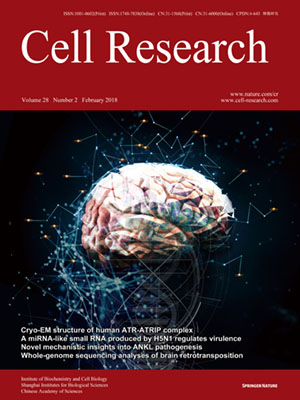
Volume 28, No 2, Feb 2018
ISSN: 1001-0602
EISSN: 1748-7838 2018
impact factor 17.848*
(Clarivate Analytics, 2019)
Volume 28 Issue 2, February 2018: 187-203
ORIGINAL ARTICLES
Whole-genome sequencing reveals principles of brain retrotransposition in neurodevelopmental disorders
Jasmine Jacob-Hirsch, Eran Eyal, Binyamin A Knisbacher, Jonathan Roth, Karen Cesarkas, Chen Dor, Sarit Farage-Barhom, Vered Kunik, Amos J Simon, Moran Gal, Michal Yalon, Sharon Moshitch-Moshkovitz, Rick Tearle, Shlomi Constantini, Erez Y Levanon, Ninette Amariglio & Gideon Rechavi
Correspondence:
Neural progenitor cells undergo somatic retrotransposition events, mainly involving L1 elements, which can be potentially deleterious. Here, we analyze the whole genomes of 20 brain samples and 80 non-brain samples, and characterized the retrotransposition landscape of patients affected by a variety of neurodevelopmental disorders including Rett syndrome, tuberous sclerosis, ataxia-telangiectasia and autism. We report that the number of retrotranspositions in brain tissues is higher than that observed in non-brain samples and even higher in pathologic vs normal brains. The majority of somatic brain retrotransposons integrate into pre-existing repetitive elements, preferentially A/T rich L1 sequences, resulting in nested insertions. Our findings document the fingerprints of encoded endonuclease independent mechanisms in the majority of L1 brain insertion events. The insertions are “non-classical” in that they are truncated at both ends, integrate in the same orientation as the host element, and their target sequences are enriched with a CCATT motif in contrast to the classical endonuclease motif of most other retrotranspositions. We show that L1Hs elements integrate preferentially into genes associated with neural functions and diseases. We propose that pre-existing retrotransposons act as “lightning rods” for novel insertions, which may give fine modulation of gene expression while safeguarding from deleterious events. Overwhelmingly uncontrolled retrotransposition may breach this safeguard mechanism and increase the risk of harmful mutagenesis in neurodevelopmental disorders.
10.1038/cr.2018.8
FULL TEXT | PDF
Browse 4449


